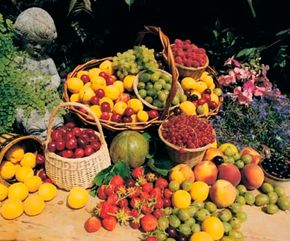 “Fruits come in all shapes, sizes and tastes,and best of all are naturally prepackaged.See more pictures of fruit.Stockbyte
“Fruits come in all shapes, sizes and tastes,and best of all are naturally prepackaged.See more pictures of fruit.Stockbyte
Every season has its culinary highlights, but summer offers the widest variety of fresh fruit. The bounty ranges from lush, ripe peaches and plump berries to refreshing melons and grapes. There isn’t a taste bud on the planet that won’t enjoy some type of fresh fruit. Unfortunately, people who are newly diagnosed with diabetes are often afraid to eat it.
The good news: Whether you have type 1 or type 2 diabetes, there’s nothing that should stop you from fitting fresh summer fruits into your eating plan. Not only are fruits delicious — they’re low in fat and calories, packed with vitamins and minerals, and they can satisfy your sweet tooth. Many types of fruits even make easy, portable snacks. The key is to be strategic about eating fruit.
Rule #1: Opt for pieces of fruit instead of fruit juice.
In its natural, fresh state, fruit does contain sugar. However, the amount of sugar in most fresh fruit is relatively small, especially when compared to fruit juices. As an added benefit, the sugar in most fresh fruits comes "wrapped" in fiber, which lessens its effect on your blood glucose.
Rule #2: Choose proper portions.
If you chug down a 12- to 16-ounce container of juice, you may not realize you’ve had 3 to 4 fruit exchanges and many more calories than you wanted. With pieces of fruit, portion control is easier. Keep in mind that an "average" apple or pear in the supermarket today is oversized compared to fruits a few years ago and can top 100 calories. Cut large fruits in half, or count a whole piece as 2 fruit exchanges.
Rule #3: Aim for a wide variety of fruit choices.
Eating different types of fruits provides your body with benefits from the broadest range of nutrients. Some of the best, lowest-sugar fruit choices include melons such as cantaloupe, honeydew, and watermelon; berries such as strawberries, raspberries, blackberries, and blueberries; and grapefruit, apricots, peaches, pears, oranges, plums, and mangos.
Tips for Adding Fruits to Your Diet
Following are easy ways to enjoy summer’s fresh fruit:
- Top cold cereal with sliced peaches; cook apricots in hot cereal.
- Keep a plastic container full of cut-up fruit in your refrigerator. Eat a serving at breakfast or for a snack topped with plain nonfat yogurt.
- Top salads with pieces of pineapple, mango, kiwi, or apples.
- Take a few pieces of fruit with you to work, so it’s easy to eat a piece at lunch or for a snack. It’s also a great strategy for keeping a ravenous appetite at bay on the way home.
- Toss fruit into entrées: Add a few slices of pineapple to a stir-fry or make-your-own pizza; fresh cranberries or peaches in chicken; or apricots or apples in pork dishes.
- Combine fruit with vegetables: crushed pineapple with coleslaw; a low-fat Waldorf salad with apples, raisins, walnuts, and celery served over romaine lettuce.
- Grill fruit on skewers and serve as dessert with ginger snaps or vanilla wafers, or as part of the main course.
- Process strawberries, raspberries, or blueberries in a blender to make a salad dressing or a topping for frozen yogurt or pound cake. Create a cooling berry soup as a first course. Complement a main dish with fruit: pineapple slices with ham or low-sugar cranberry sauce with chicken.
Lots More Information
Related Articles
- Fruit Questions
- How to Prepare Fruit
- Cranberries 101
- 5 Autumn Apples







































